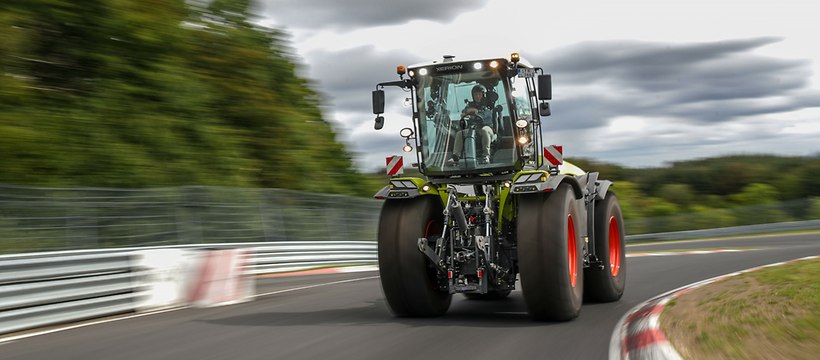

The system tractor.
Larger, more powerful, more efficient: in the 25 years of its existence, the XERION has evolved in many respects. But the core feature of the machine remains – it is considerably more versatile than ordinary tractors.
The farming world had never seen a tractor like it. When the first XERION, the 2500, hit the market in 1997, it left industry professionals speechless: 250 hp, continuously variable transmission, four equal-size wheels, two steerable axles, four mounting spaces at the front and rear and a rotating cab. A range of attachments – including for forage harvesting or beet lifting – indicated that this machine was far more than a farm tractor. And that's exactly what the XERION was intended to be right from the start.
Developing a system tractor that can be used all year round and can also handle harvesting tasks – that was the vision that CLAAS had been working towards all those years. The XERION 2500 could perform not just traditional tasks such as tillage, drilling and baling, it could also be used as a self-propelled harvesting machine. And with special mounted implements it could even be used for beet lifting, wood chipping and other specialist applications.
It's precisely because of this versatility that the XERION initially failed to win the approval of customers. "Many wondered why the tractor needed so many functions in the first place", explained Helmut-Hendrik Heppe, Product Manager for tractors at CLAAS. "It took a while for farmers to appreciate the benefits that this machine could offer."
From 250 to 530 hp.
By 2004 – with the launch of the XERION 3800/3300 – the tractor concept had finally become established. Today the XERION is used by farmers and contractors throughout the world. Up to 400 machines are produced each year.
In recent decades the XERION has grown in every respect. While the XERION 2500 was 6.30 m long and 3.50 m high, the latest XERION 5000 has a length of 7.49 m and a height of up to 3.80 m. The wheels, once 1.95 m high, are now 2.25 m. The engine capacity has risen from the original 8 to 12 l and the output from 250 to 530 hp. The number of spool valves has doubled from an original four to eight.
The number of XERION variants has also increased. It is now available as TRAC, TRAC VC and SADDLE TRAC with the cab positioned over the engine. The on-board equipment has also become more sophisticated. Take the control terminal, for example – the CLAAS electronic on-board information system CEBIS – now has a high-resolution colour display and camera displays.

Versatility, efficiency, soil protection and performance.
But the multi-functional nature of the XERION has remained the same for years. Admittedly the combine harvester and beet lifter attachments failed to take off. But nowadays, among other things, the tractor is used for manure spreading, for harvesting operations with a transfer vehicle, and on the silage clamp. It has also made a name for itself for various specialist tasks, such as wood chipping and snow clearing.
"The XERION owes its enduring popularity to the fact that it combines versatility with efficiency, soil protection and performance", explains Product Manager Helmut-Hendrik Heppe. "This is mainly down to its large engine with high capacity and high torque, high tractive power and soil-friendly crab steering mode."

The tractor's popularity has also been born out by various promotional stunts. For example, in 2020 racing driver Christian Menzel drove the XERION 5000 round the legendary 20.6 km long northern loop of the Nürburgring – backwards, with the cab rotated. "That was by far the most unusual thing I've ever done," said Menzel, after crossing the finish line with the 17 t machine. Even on the race track, the XERION is so much more than a farm tractor.











